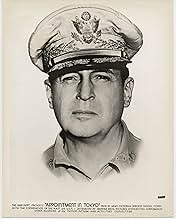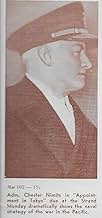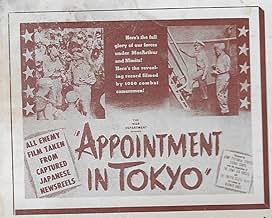Agrega una trama en tu idiomaMilitary documentary about the four years of Pacific war detailing the history of the defeat of Japan.Military documentary about the four years of Pacific war detailing the history of the defeat of Japan.Military documentary about the four years of Pacific war detailing the history of the defeat of Japan.
Douglas MacArthur
- Self
- (material de archivo)
Chester W. Nimitz
- Self
- (material de archivo)
Jonathan M. Wainwright
- Self
- (material de archivo)
- (as Gen. Jonathan M. Wainwright)
William F. Halsey
- Self
- (sin créditos)
Argumento
¿Sabías que…?
- TriviaWorking title was "Appointment in Corregidor", but before the film was released to theaters, the Japanese surrendered to the U.S. on September 2, 1945. Additional footage was added to the completed documentary and the title was changed to reflect the victory.
- Citas
Narrator: [as ground troops push their way inland, after landing on Leyte, Philippines, late 1944] To the infantry, it was just another day to keep pushing. The speed and dash of the first days are gone. You're not front-page headlines anymore. And being dry is something you've forgotten. You march in mud. You eat in mud. You rest in mud. You sleep in mud. And as long as men remember war, they'll remember mud.
- Créditos curiososDistributed through the War Activities Committee of the Motion Picture Industry and exhibited through the cooperation of this Theater.
Opinión destacada
This was released in 1945 and it shows because it is very dated. The Japanese are evil incarnated -- "bandy legged Nip infantrymen" the narrator calls them at one point -- and we see plenty of Japanese bodies, dead and dying. The Americans are fearless, defiant, homesick, and religious. In fact they're very religious. Some of the footage is news film, some is staged, and some captured from the Japanese.
Here's an example of how the Americans are treated. Any recent history book will refer to the battle of Leyte Gulf as "controversial." The reason it's controversial is that Admiral Halsey took off with his entire fleet to engage a Japanese force that was designed to lure him into doing just that. It left the back door open to another Japanese force which could have sailed down to our ongoing landings at Leyte Gulf and demolished them. That they did not do that is due to confusion and lack of communications among the Japanese. As it was, the Japanese turned away only at the last minute.
How does the film handle the battle of Leyte Gulf. It was very simple. The Japanese sent three naval forces against the landings. We also sent three forces against theirs, and we defeated them. No room for confusion here.
Of course it's easy to criticize inaccuracies or editorial twists in a movie shot and put together in the final months of the war. As propaganda it stacks up fairly well, no worse than Frank Capra's "Why We Fight" series, but not nearly as good as Leni Riefenstahl's "Triumph of the Will" or John Huston's "The Battle of San Pietro." It lacks any artistry in the shooting (which is understandable) or in the narration (which is less excusable).
On the whole it is a paean to General Douglas MacArthur. The flag is raised over a reconquered Leyte as "the general fulfills a soldier's promise." What's really exceptional about it is the combat footage of the U. S. Army in the Southwest Pacific. There are many familiar shots, but many more that don't show up very often in documentaries or feature films. Mostly we've seen on screen color film of combat involving the Marines and Naval air. Here we see ordinary army grunts slogging through the mud or fighting house to house to take Manila.
Much of the attention in the Pacific has gone to the Marine Corps and Navy in the Central Pacific, island hopping from one famous name to another. The fighting under MacArthur was brutal too but perhaps we know less about it because it was a bit more difficult to figure out why it was taking place. What I mean, for instance, is that the islands of the Central Pacific had strategic importance. The Marines took Saipan because from its airfields our bombers could reach the Japanese mainland. Much of MacArthur's battles had no simple explanation.
Anyway, yes, it twists history, as expected, but maybe its simplicity makes it that much more effective as a learning experience. Let's shave off the rough edges if it helps today's generation of students get at least some grasp of what World War II was about. A poll of high school seniors taken about 15 years ago showed that a substantial number didn't know which side Japan fought on. What was once propaganda may now serve another purpose -- straightforward education, with glosses by the teacher.
Here's an example of how the Americans are treated. Any recent history book will refer to the battle of Leyte Gulf as "controversial." The reason it's controversial is that Admiral Halsey took off with his entire fleet to engage a Japanese force that was designed to lure him into doing just that. It left the back door open to another Japanese force which could have sailed down to our ongoing landings at Leyte Gulf and demolished them. That they did not do that is due to confusion and lack of communications among the Japanese. As it was, the Japanese turned away only at the last minute.
How does the film handle the battle of Leyte Gulf. It was very simple. The Japanese sent three naval forces against the landings. We also sent three forces against theirs, and we defeated them. No room for confusion here.
Of course it's easy to criticize inaccuracies or editorial twists in a movie shot and put together in the final months of the war. As propaganda it stacks up fairly well, no worse than Frank Capra's "Why We Fight" series, but not nearly as good as Leni Riefenstahl's "Triumph of the Will" or John Huston's "The Battle of San Pietro." It lacks any artistry in the shooting (which is understandable) or in the narration (which is less excusable).
On the whole it is a paean to General Douglas MacArthur. The flag is raised over a reconquered Leyte as "the general fulfills a soldier's promise." What's really exceptional about it is the combat footage of the U. S. Army in the Southwest Pacific. There are many familiar shots, but many more that don't show up very often in documentaries or feature films. Mostly we've seen on screen color film of combat involving the Marines and Naval air. Here we see ordinary army grunts slogging through the mud or fighting house to house to take Manila.
Much of the attention in the Pacific has gone to the Marine Corps and Navy in the Central Pacific, island hopping from one famous name to another. The fighting under MacArthur was brutal too but perhaps we know less about it because it was a bit more difficult to figure out why it was taking place. What I mean, for instance, is that the islands of the Central Pacific had strategic importance. The Marines took Saipan because from its airfields our bombers could reach the Japanese mainland. Much of MacArthur's battles had no simple explanation.
Anyway, yes, it twists history, as expected, but maybe its simplicity makes it that much more effective as a learning experience. Let's shave off the rough edges if it helps today's generation of students get at least some grasp of what World War II was about. A poll of high school seniors taken about 15 years ago showed that a substantial number didn't know which side Japan fought on. What was once propaganda may now serve another purpose -- straightforward education, with glosses by the teacher.
- rmax304823
- 4 ene 2005
- Enlace permanente
Selecciones populares
Inicia sesión para calificar y agrega a la lista de videos para obtener recomendaciones personalizadas
Detalles
- Tiempo de ejecución56 minutos
- Color
- Mezcla de sonido
- Relación de aspecto
- 1.37 : 1
Contribuir a esta página
Sugiere una edición o agrega el contenido que falta

Principales brechas de datos
By what name was Appointment in Tokyo (1945) officially released in Canada in English?
Responda




























